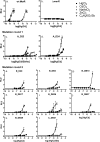Cd-specific mutants of mercury-sensing regulatory protein MerR, generated by directed evolution
- PMID: 21764963
- PMCID: PMC3165431
- DOI: 10.1128/AEM.00662-11
Cd-specific mutants of mercury-sensing regulatory protein MerR, generated by directed evolution
Abstract
The mercury-sensing regulatory protein, MerR (Tn21), which regulates mercury resistance operons in Gram-negative bacteria, was subjected to directed evolution in an effort to generate a MerR mutant that responds to Cd but not Hg. Oligonucleotide-directed mutagenesis was used to introduce random mutations into the key metal-binding regions of MerR. The effects of these mutations were assessed using a vector in which MerR controlled the expression of green fluorescent protein (GFP) and luciferase via the mer operator/promoter. An Escherichia coli cell library was screened by fluorescence-activated cell sorting, using a fluorescence-based dual screening strategy that selected for MerR mutants that showed GFP repression when cells were induced with Hg but GFP activation in the presence of Cd. Two Cd-responsive MerR mutants with decreased responses toward Hg were identified through the first mutagenesis/selection round. These mutants were used for a second mutagenesis/selection round, which yielded eight Cd-specific mutants that had no significant response to Hg, Zn, or the other tested metal(loid)s. Seven of the eight Cd-specific MerR mutants showed repressor activities equal to that of wild-type (wt) MerR. These Cd-specific mutants harbored multiple mutations (12 to 22) in MerR, indicating that the alteration of metal specificity with maintenance of repressor function was due to the combined effect of many mutations rather than just a few amino acid changes. The amino acid changes were studied by alignment against the sequences of MerR and other metal-responsive MerR family proteins. The analysis indicated that the generated Cd-specific MerR mutants appear to be unique among the MerR family members characterized to date.
Figures




Similar articles
-
Cd(II)-responsive and constitutive mutants implicate a novel domain in MerR.J Bacteriol. 1999 Jun;181(11):3462-71. doi: 10.1128/JB.181.11.3462-3471.1999. J Bacteriol. 1999. PMID: 10348859 Free PMC article.
-
Genetic analysis of the Tn21 mer operator-promoter.J Bacteriol. 1992 Apr;174(7):2160-71. doi: 10.1128/jb.174.7.2160-2171.1992. J Bacteriol. 1992. PMID: 1312997 Free PMC article.
-
19F-NMR reveals metal and operator-induced allostery in MerR.J Mol Biol. 2007 Aug 3;371(1):79-92. doi: 10.1016/j.jmb.2007.04.085. Epub 2007 May 10. J Mol Biol. 2007. PMID: 17560604
-
Bacterial resistances to inorganic mercury salts and organomercurials.Plasmid. 1992 Jan;27(1):4-16. doi: 10.1016/0147-619x(92)90002-r. Plasmid. 1992. PMID: 1311113 Review.
-
The MerR family of transcriptional regulators.FEMS Microbiol Rev. 2003 Jun;27(2-3):145-63. doi: 10.1016/S0168-6445(03)00051-2. FEMS Microbiol Rev. 2003. PMID: 12829265 Review.
Cited by
-
Anthocyanin biosynthetic pathway switched by metalloregulator PbrR to enable a biosensor for the detection of lead toxicity.Front Microbiol. 2022 Oct 4;13:975421. doi: 10.3389/fmicb.2022.975421. eCollection 2022. Front Microbiol. 2022. PMID: 36267188 Free PMC article.
-
Complete Genome Sequence of a Marine Bacterium, Pseudomonas pseudoalcaligenes Strain S1, with High Mercury Resistance and Bioaccumulation Capacity.Genome Announc. 2016 May 19;4(3):e00381-16. doi: 10.1128/genomeA.00381-16. Genome Announc. 2016. PMID: 27198018 Free PMC article.
-
The protein scaffold calibrates metal specificity and activation in MerR sensors.Microb Biotechnol. 2022 Dec;15(12):2992-3002. doi: 10.1111/1751-7915.14151. Epub 2022 Sep 22. Microb Biotechnol. 2022. PMID: 36134649 Free PMC article.
-
Duckweed: a potential phytosensor for heavy metals.Plant Cell Rep. 2022 Dec;41(12):2231-2243. doi: 10.1007/s00299-022-02913-7. Epub 2022 Aug 18. Plant Cell Rep. 2022. PMID: 35980444 Review.
-
An Automated Cell-Free Workflow for Transcription Factor Engineering.ACS Synth Biol. 2024 Oct 18;13(10):3389-3399. doi: 10.1021/acssynbio.4c00471. Epub 2024 Oct 7. ACS Synth Biol. 2024. PMID: 39373325 Free PMC article.
References
-
- Ansari A. Z., Chael M. L., O'Halloran T. V. 1992. Allosteric underwinding of DNA is a critical step in positive control of transcription by Hg-MerR. Nature 355:87–89 - PubMed
-
- Barrineau P., et al. 1984. The DNA sequence of the mercury resistance operon of the IncFII plasmid NR1. J. Mol. Appl. Genet. 2:601–619 - PubMed
-
- Brocklehurst K. R., et al. 1999. ZntR is a Zn(II)-responsive MerR-like transcriptional regulator of zntA in Escherichia coli. Mol. Microbiol. 31:893–902 - PubMed
-
- Brocklehurst K. R., Megit S. J., Morby A. P. 2003. Characterisation of CadR from Pseudomonas aeruginosa: a Cd(II)-responsive MerR homologue. Biochem. Biophys. Res. Commun. 308:234–239 - PubMed
-
- Brown N. L., Ford S. J., Pridmore R. D., Fritzinger D. C. 1983. Nucleotide-sequence of a gene from the Pseudomonas transposon Tn501 encoding mercuric reductase. Biochemistry 22:4089–4095 - PubMed
Publication types
MeSH terms
Substances
LinkOut - more resources
Full Text Sources
Other Literature Sources
Miscellaneous

